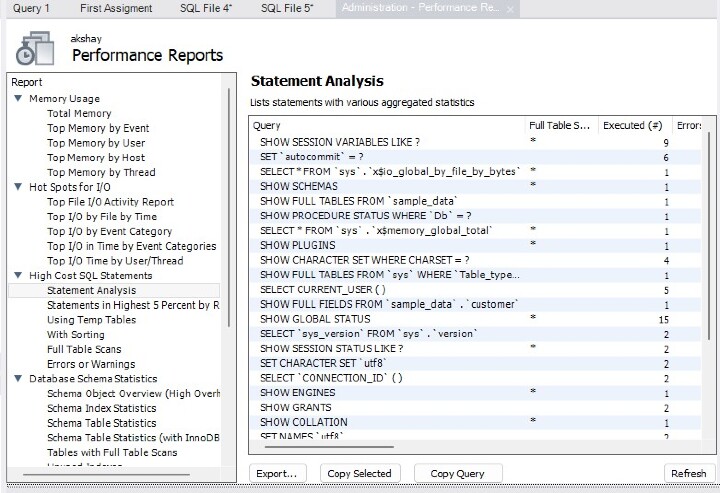
 Data Structure
Data Structure Networking
Networking RDBMS
RDBMS Operating System
Operating System Java
Java MS Excel
MS Excel iOS
iOS HTML
HTML CSS
CSS Android
Android Python
Python C Programming
C Programming C++
C++ C#
C# MongoDB
MongoDB MySQL
MySQL Javascript
Javascript PHP
PHP
- Selected Reading
- UPSC IAS Exams Notes
- Developer's Best Practices
- Questions and Answers
- Effective Resume Writing
- HR Interview Questions
- Computer Glossary
- Who is Who
Performance Report Controls in Mysql Workbench
The controls listed below can be used to examine and export performance report data (see the following figure) ?
Export ? Export all entries from the current performance report, including all queries and values, together with any associated data (including column headings). opens an export file dialogue.
Copy Selected ? Copies a single entry from the current performance report together with any related data (and column titles). the system's clipboard is saved. a case in point
Query Copy ? This function copies the SQL statement that produced the performance report. the system clipboard is saved.
Refresh ? The performance report is refreshed (reloaded).
Performance Report Descriptions
Reports on Performance: Statement Analysis

The following groupings are shown for individual reports ?
Memory Usage
Total Memory ? Shows total memory allocated.
Top Memory by Event ? Shows events consuming the most memory.
Top Memory by User ? Shows users consuming the most memory
Top Memory by Host ? Shows hosts consuming the most memory.
Top Memory by Thread ? Shows threads consuming the most memory.
Hot Spots for I/O
Top File I/O Activity Report ? Shows the files with the most I/O usage in bytes.
Top I/O by File by Time ? Shows the highest I/O usage by file and latency.
Top I/O by Event Category ? Shows the highest I/O data usage by event categories.
Top I/O in Time by Event Categories ? Shows the highest I/O time consumers by event categories.
Top I/O by User/Thread ? Shows the top I/O time consumers by user and thread.
High-Cost SQL Statements
Statement Analysis ? Lists statements with various aggregated statistics.
Statements in the Highest 5 percent by Runtime ? Lists all statements in which the average runtime (in microseconds) is in the highest five percent.
Using Temp Tables ? Lists all statements that use temporary tables (access the highest percentage of disk temporary tables, then memory temporary tables).
With Sorting ? Lists all normalized statements that have done sorts (access in the following priority order: sort_merge_passes, sort_scans, and sort_rows).
Full Table Scans ? Lists statements that have performed a full table scan. Access query performance and the WHERE clause (or clauses). If no index is used, consider adding indexes for large tables.
Errors or Warnings ? Lists statements that have raised errors or warnings.
Database Schema Statistics
Schema Object Overview (High Overhead) ? Shows the count by object for each schema. Note that for instances with a large number of objects, this report may require extended time to execute.
Schema Index Statistics ? Shows the general statistics related to indexes.
Schema Table Statistics ? Shows the general statistics related to tables.
Schema Table Statistics (with InnoDB buffer) ? Shows schema tables with InnoDB buffer statistics.
Tables with Full Table Scans ? Finds tables that are being accessed by full table scans, ordering by the number of rows scanned (descending).
Unused Indexes ? Shows the list of indexes that were never used since the server started or since P_S data collection started.
Wait Event Times (Expert)
Global Waits by Time ? Lists the top global wait events by their total time, ignoring idle (this may not be very large).
Waits by User by Time ? Lists the top wait events by user and by their total time, ignoring idle (this may not be very large).
Wait Classes by Time ? Lists the top wait classes by total time, ignoring idle (this may not be very large).
Waits Classes by Average Time ? Lists the top wait classes by average time, ignoring idle (this may not be very large).
InnoDB Statistics
InnoDB Buffer Stats by Schema ? Summarizes the output of the INFORMATION_SCHEMA.INNODB_BUFFER_PAGE table, aggregating by the schema.
InnoDB Buffer Stats by Table ? Summarizes the output of the INFORMATION_SCHEMA.INNODB_BUFFER_PAGE table, aggregating by schema and table name.
User Resource Use
Overview ? Shows the resource use summary for each user.
I/O Statistics ? Shows the I/O use for each user.
Statement Statistics ? This shows the statement execution statistics for each user.
Conclusion
In this article, we have learned about different Performance report control and how to get them using mysql workbench.

